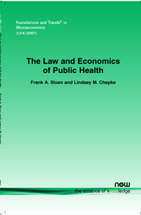The Law and Economics of Public Health
By Frank A. Sloan, Center for Health Policy, Duke University, USA, fsloan@duke.edu | Lindsey M. Chepke, Center for Health Policy, Duke University, USA, lchepke@duke.edu
Abstract
The fundamental question addressed by this paper is whether or not and the extent to which imposing tort liability on potential injurers improves the public's health. Conceptually, imposing the threat of litigation on potential injurers gives them an incentive to exercise more care than they would absent the threat. While the conclusion might seem to be obvious at first glance, in reality, the conclusion is far from obvious. For one, insurance coverage may blunt incentives to take care. Also, the tort system may operate far less perfectly than the theory would have it. In the end, the question must be answered on the basis of empirical evidence.
The Law and Economics of Public Health
The Law and Economics of Public Health synthesizes the empirical research findings on the relationship between law and the public's health that are found scattered in different literature ranging from economic journals to medical journals, journals on addictive behaviors, law reviews, and books. This is the only study to date that has assembled the empirical evidence from many areas ranging from motor vehicle liability and dram shop liability to medical malpractice, products liability as it applies to pharmaceutical products, and medical devices. The Law and Economics of Public Health addresses the fundamental question as to whether or not and the extent to which imposing tort liability on potential injurers improves the public's health. Does the threat of litigation on potential injurers make them exercise more caution? Does insurance coverage counter incentives to be careful? Does the tort system operate as perfectly as the theory would have it? This monograph answers these questions on the basis of empirical evidence. The Law and Economics of Public Health discusses both theory and empirical evidence in several areas of personal injury to which tort liability has been applied. The monograph starts by describing the general law and economics framework used to assess both positive and normative issues relating to tort liability. It then presents the rationale for and empirical evidence on particular applications of tort liability as it applies to personal injury.
